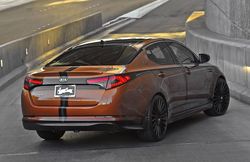Cars for sale!
 My son has bought himself a new car at $34300 from a shop after three successive discount of
3
0
%
. When I went to the shop, they did not offer any more discounts, and I still bought the same car.
My son has bought himself a new car at $34300 from a shop after three successive discount of
3
0
%
. When I went to the shop, they did not offer any more discounts, and I still bought the same car.
How much did my family (both my son and I) spend on cars?
Image credit: Wikipedia NRMA Motoring and Services
The answer is 134300.
This section requires Javascript.
You are seeing this because something didn't load right. We suggest you, (a) try
refreshing the page, (b) enabling javascript if it is disabled on your browser and,
finally, (c)
loading the
non-javascript version of this page
. We're sorry about the hassle.
3 solutions
Let the actual cost of the car before discount be x .
After the 1st discount the cost is x − 1 0 0 3 0 x = 1 0 0 7 0 x .
Similarly after the 2nd discount the cost is 1 0 0 7 0 x − 1 0 0 3 0 x × 1 0 0 7 0 x = 1 0 0 4 9 x .
Same way is followed and after the 3rd discount the cost will be 1 0 0 0 3 4 3 x .( After this no further discount is implemented.)
Now, we get 1 0 0 0 3 4 3 x = 3 4 3 0 0 .
Thus, the actual cost of the car was $ 1 0 0 0 0 0 .
Therefore, the total money spent on the cars is 3 4 3 0 0 + 1 0 0 0 0 0 = $ 1 3 4 3 0 0 ( It is because the father bought the car without any discount.)
If a 30% discount has been applied, we can assume that our price is 0.7 of the original. therefore we can divide by 7 and multiply by ten, We do this three times for the three successive discounts of 30% which gives us a price of $100000. We add these together to get $134300
Let x be the original price. The first discount is x − 0 . 3 x = 0 . 7 x . The second discount is 0 . 7 x − 0 . 3 ( 0 . 7 x ) = 0 . 4 9 x . The third discount is 0 . 4 9 x − 0 . 3 ( 0 . 4 9 x ) = 0 . 3 4 3 x .
Then
0 . 3 4 3 x = 2 4 3 0 0
x = 1 0 0 0 0 0
t o t a l a m o u n t = 1 0 0 0 0 0 + 3 4 3 0 0 = 1 3 4 3 0 0